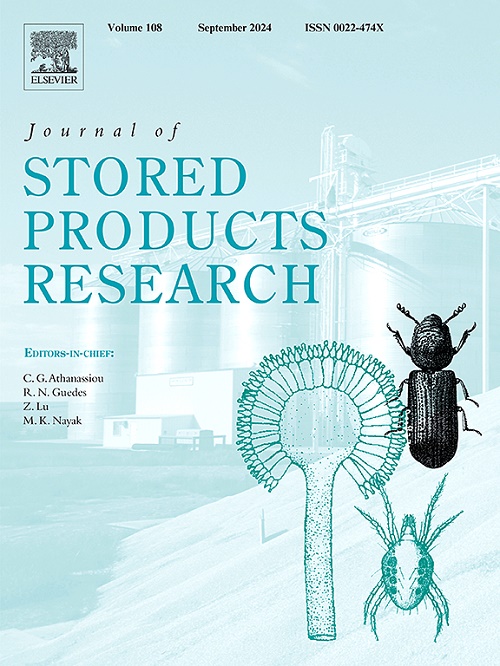Development of Idaea inquinata (Lepidoptera Geometridae) at different constant temperatures and relative humidities under controlled conditions
IF 2.7
2区 农林科学
Q1 ENTOMOLOGY
引用次数: 0
Abstract
The rusty wave moth Idaea inquinata is an insect pest that infests dried herbs, above all when stored in warehouses. Infestations were historically localised, but the recent climatic change might increase the incidence of this pest in many areas of north Italy. The artificial regulation of the environmental conditions of warehouses is one of the most common techniques to control pests, often combined with thermal treatments just after the introduction of the stocks. The optimisation of the warehouse conditions, however, requires a deep knowledge on how the species react to variations in temperature and relative humidities. This information is to date missing for I. inquinata and this work aimed to fill this gap in knowledge. The life tables at 35% and 70% RH, and at different constant temperatures were obtained for the egg, larval, and pupal stages by combining datasets provided by 20 years of continuous rearing of this species. A second part of the study, instead, concerned the estimation of the parameters of the temperature-dependent development rate functions, laying the foundations for further formulations of mathematical models to be applied in decision support systems. Life tables showed that conditions of low relative humidities and low temperatures are a good compromise that slows down the development time of the preimaginal stages. The upper thermal limit for the development of this species, instead, is around 40 °C, a threshold that can be considered for further thermal treatments to disinfest warehouses before the introduction of pest-free stocks or as a controlling action in case of infestations.
Idaea inquinata(鳞翅目尺蠖科)在受控条件下不同恒温和相对湿度下的发育情况
锈波蛾(Idaea inquinata)是一种为害干药草的害虫,尤其是在仓库中储存时。这种虫害历来局限于局部地区,但最近的气候变化可能会增加这种虫害在意大利北部许多地区的发生率。人工调节仓库的环境条件是控制害虫最常用的技术之一,通常在引入存货后与热处理相结合。然而,优化仓库条件需要深入了解物种对温度和相对湿度变化的反应。迄今为止,I. inquinata 还没有这方面的信息,这项工作旨在填补这一知识空白。通过结合对该物种长达 20 年的连续饲养数据集,获得了在 35% 和 70% 相对湿度以及不同恒温条件下卵、幼虫和蛹各阶段的生命表。研究的第二部分则是估算与温度有关的发育速率函数参数,为进一步建立数学模型以应用于决策支持系统奠定基础。生命表显示,低相对湿度和低温是一个很好的折衷条件,可以减缓前胚胎阶段的发育时间。相反,该物种发育的热上限约为 40 °C,在引入无害虫存货之前,可考虑对仓库进行进一步的热处理消毒,或在发生虫害时采取控制措施。
本文章由计算机程序翻译,如有差异,请以英文原文为准。
求助全文
约1分钟内获得全文
求助全文
来源期刊
CiteScore
5.70
自引率
18.50%
发文量
112
审稿时长
45 days
期刊介绍:
The Journal of Stored Products Research provides an international medium for the publication of both reviews and original results from laboratory and field studies on the preservation and safety of stored products, notably food stocks, covering storage-related problems from the producer through the supply chain to the consumer. Stored products are characterised by having relatively low moisture content and include raw and semi-processed foods, animal feedstuffs, and a range of other durable items, including materials such as clothing or museum artefacts.

 求助内容:
求助内容: 应助结果提醒方式:
应助结果提醒方式:


